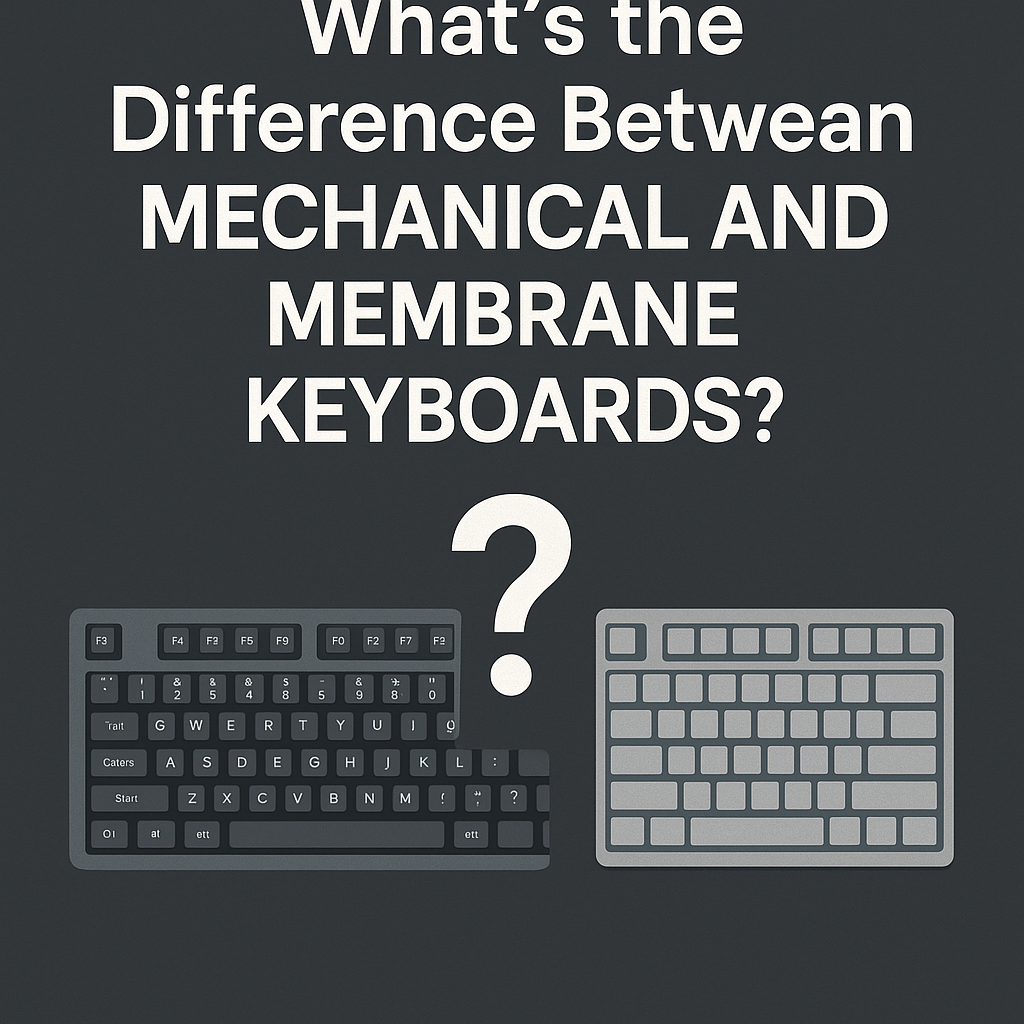Mechanical vs Membrane Keyboards: What You Need to Know
Among computer peripherals, the keyboard is one of the most important devices that directly affects your experience. Mechanical keyboards have become increasingly popular thanks to their excellent tactile feedback and durability, while traditional membrane keyboards still hold market share due to their lower price and quiet operation. So what's the real difference between the two? And how do you choose the one that suits you best? Let’s find out.
What Is a Mechanical Keyboard?
1. Mechanical vs. Membrane Keyboard: Key Differences
1) Internal Structure
Mechanical Keyboards:
Each key has its own dedicated switch, such as mechanical switches (Cherry, TTC, Gateron, Kailh), optical switches (Razer, Corsair), or magnetic switches (TTC, Kailh).
| Switch Type | Trigger Mechanism | Key Benefits | Physical Contact |
|---|---|---|---|
| Mechanical | Metal contact | Tactile feedback, broad variety | ✅ Yes |
| Optical | Infrared light interruption | Fast, durable, no debounce | ❌ No |
| Magnetic (Hall) | Magnetic field sensing | Adjustable actuation, analog input | ❌ No |
- Mechanical: Two metal contacts close when the key is pressed to send a signal.
- Optical: A beam of infrared light is interrupted or redirected by the stem to trigger input.
-
Magnetic (Hall Effect): A magnet changes position and alters the magnetic field, which is detected by a sensor to register input.
Result: clear tactile feel and long lifespan.
Membrane Keyboards:
Use a 3-layer membrane circuit to register input through pressure. The keystroke feels soft and spongy, and keys can wear out over time, leading to failures.
✅ Summary: Mechanical switches—whether tactile, linear, optical, or magnetic—offer significantly clearer and more reliable feedback than the soft, mushy feel of membrane keyboards.
2) Typing Feel
Mechanical Keyboards:
- Offer various switch types (Red, Blue, Brown, Black, Optical, Magnetic) to suit typing, gaming, or hybrid needs.
- Optical and magnetic switches enable ultra-fast actuation and even adjustable actuation points, far more responsive than rubber-dome membrane designs.
- Provide consistent key feel across the board, unlike membrane keyboards where key feel can vary.
Membrane Keyboards:
Typing feels softer and less defined. Long-term use can lead to fatigue due to inconsistent feedback.
3) Durability
Mechanical Keyboards:
Each switch can last 50 to 100 million keystrokes, with some high-end switches even exceeding 100 million.
Membrane Keyboards:
Typically last around 5 million keystrokes, and key failures are more common with extended use.
4) Price
Mechanical Keyboards:
Generally more expensive. Entry-level models start at around $70, while custom builds can exceed several hundred dollars.
Membrane Keyboards:
Budget-friendly, usually $10–30.
5) Noise
Mechanical Keyboards:
Not necessarily louder than membrane keyboards. Silent switches (e.g., Silent Red, Silent Black), optical, and magnetic switches can be very quiet. With damping structures, foam padding, and gentle typing, mechanical keyboards can be quieter than some membrane models, making them suitable for offices or quiet environments.
Membrane Keyboards:
Generally quiet due to their soft rubber domes.
6) Customization and Ergonomics
Mechanical Keyboards:
- Most support keycap replacement, hot-swappable switches, and adjustable actuation (for optical/magnetic types).
- Offer ergonomic keycap profiles (OEM, Cherry, SA) and stepped layouts to reduce finger strain.
Membrane Keyboards:
Limited to no customization options.
🎯 Which Switch Is Best for Gaming and How Programmers Choose Keyboards?
1) Choose Based on Usage Scenario
| User Type | Recommended Switches | Focus Areas | Ideal Layout |
|---|---|---|---|
| Gamers | Red, Silver, Optical, Magnetic | Speed, RGB, Anti-Ghosting | TKL / Full-size |
| Office Users | Silent Red/Brown, Silent Magnetic | Quiet, Comfort, Long Sessions | TKL / 96% Layout |
| Developers | Brown, Red, Silent, Magnetic | Programmability, Stability, Ergonomics | 75% / 98% / Split |
🕹️ A. Gamers
Needs: Fast response, low latency, anti-ghosting, flashy aesthetics
Recommended switches:
- Linear Red / Silver / Optical switches: Fast actuation for FPS, MOBA
- Magnetic switches: Adjustable actuation point for fine control
Features to look for:
NKRO (N-key rollover)
Macro programming
RGB backlighting
Anti-slip, oil-resistant keycaps (PBT recommended)
🎯 Best for those who value performance, precision, and gaming atmosphere.
💼 B. Office / Writers
Needs: Comfortable feel, quiet typing, fatigue-free for long sessions
Recommended switches:
- Silent Red / Silent Brown / Silent Magnetic: Soft and quiet for shared spaces
- Brown / Soft tactile: Mild feedback without excessive noise
Features to look for:
Silent construction, dampening foam
Compact but comfortable layouts (87 or 98 keys)
Ergonomic angle and wrist support
🎯 Great for quiet, efficient typing and a better work experience.
👨💻 C. Programmers / Developers
Needs: Consistent feel, long-term comfort, programmable features
Recommended switches:
- Brown / Red / Silent switches: Balanced feedback and comfort
- Magnetic switches: Adjustable to match typing style
Features to look for:
QMK/VIA key mapping support
Layer switching, macro programming
Hot-swappable sockets
OS compatibility (Mac/Win/Linux)
🎯 Ideal for efficient coding, customization, and long work hours.
2) Choose by Switch Type
| Switch Type | Key Feel | Speed | Noise Level | Customization | Best For |
|---|---|---|---|---|---|
| Mechanical | ✅✅✅ Varied | Medium | Medium–Low | ✅✅✅ | Beginners, Typists, DIYers |
| Optical | ✅✅ Smooth | ✅✅✅ Fast | ✅✅ Quiet | Moderate | Gamers, Quiet Workspaces |
| Magnetic (Hall) | ✅✅✅ Adjustable | ✅✅✅✅ Ultra Fast | ✅✅ Quiet | ✅✅✅✅ Extreme | Pro Users, Custom Setup Fans |
A. Mechanical Switches
Mechanism: Metal contact closure
Pros: Rich tactile feel, wide variety, strong typing rhythm
Best for:
Users who enjoy tactile/clicky switches (Blue, Brown)
DIY lovers and those who want to mod keycaps, switches, etc.
✅ Entry-level friendly and most common option
B. Optical Switches
Mechanism: Infrared beam interruption
Pros: Fast, no physical wear, long lifespan
Best for:
Gamers seeking speed
Quiet typists
Long-hour usage
✅ High performance with silent operation
C. Magnetic Switches (Hall Effect)
Mechanism: Magnetic field sensing
Pros: Adjustable actuation, analog input, ultra-smooth, no contact wear
Best for:
Advanced input needs (coding, creative work, sim games)
Users who want futuristic tech and full control
✅ Top-tier flexibility and innovation
3) Consider Layout
Full-size (104/108 keys): Ideal for users who need a number pad (finance, programming)
TKL (87 keys) or 60%: Saves space, perfect for gamers or minimalist setups
4) Keycap and Case Material
Keycaps:
- PBT: More durable and resistant to shine
- ABS: Smoother but prone to wear and gloss over time
Case:
- Metal: Sturdy, premium feel
- Plastic: Lightweight, but may compromise stability
✅ Conclusion
Whether you're a gamer, programmer, or office worker, choosing the right keyboard can significantly improve your productivity and comfort. As we've explored, mechanical keyboards and membrane keyboards differ greatly in terms of structure, feel, durability, and customization. Mechanical keyboards—especially those using linear, tactile, optical, or magnetic switches—offer a more responsive and personalized experience.
For those wondering how programmers choose mechanical keyboards, key factors include typing consistency, switch feedback, and layout flexibility. Features like QMK/VIA support, hot-swappable sockets, and silent switches make mechanical keyboards ideal for long coding sessions.
Meanwhile, mechanical keyboards for gaming focus on fast actuation, anti-ghosting, and RGB lighting. If you're comparing options and trying to understand the difference between mechanical and membrane keyboards, consider your usage habits, noise tolerance, and preference for switch types.
In short, the best mechanical keyboard for you depends on your work style and priorities. Whether it's custom keymapping for developers, silent switches for office use, or high-speed switches for competitive gaming, mechanical keyboards offer a level of control and satisfaction that membrane keyboards simply can’t match.
🛠 Frequently Asked Questions (FAQ)
❓What’s the difference between a mechanical keyboard and a membrane keyboard?
A:
Mechanical keyboards use individual switches under each key—mechanical, optical, or magnetic—to provide clear tactile feedback and long-lasting durability. Membrane keyboards use rubber domes to register input, which results in a softer, less defined typing feel and shorter lifespan.
❓What kind of mechanical keyboard is best for programmers?
A:
Programmers often prefer switches that are consistent and comfortable for long typing sessions, such as Brown, Red, or Silent switches. Keyboards with QMK/VIA support, hot-swappable sockets, and a compact layout (75% or 98%) are especially useful for coding workflows and custom shortcuts.
❓Which switches are ideal for gaming?
A:
Gamers typically choose Linear Red, Silver, Optical, or Magnetic switches for their fast actuation and smooth feel. Look for features like N-Key Rollover (NKRO), macro support, and RGB lighting to enhance the gaming experience.
❓Are mechanical keyboards loud?
A:
Not always. Many mechanical keyboards now offer silent switch options, such as Silent Red or Silent Magnetic switches. Combined with dampening foam and proper construction, these keyboards can be even quieter than traditional membrane keyboards, making them ideal for office or shared environments.
❓What’s the difference between mechanical, optical, and magnetic switches?
A:
-
Mechanical: Triggered by metal contact between two plates
-
Optical: Uses infrared light interruption to detect keypress
-
Magnetic (Hall Effect): Detects changes in magnetic field using a sensor
Each type offers different benefits in speed, durability, and customization potential.
❓How do I choose the right mechanical keyboard for me?
A:
Start by considering your main use case:
-
For gaming, go with fast linear or optical switches.
-
For typing and office work, choose silent or tactile switches.
-
For programming, look for keyboards with programmable layouts, ergonomic design, and stable switches.
Also consider layout (Full-size, TKL, 75%) and materials like PBT keycaps for durability and comfort.

